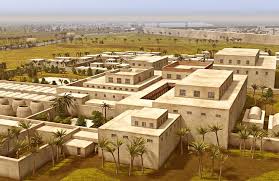Timeline / period: (1069-653 B.C.)
The Third Intermediate Period covers the centuries between the New Kingdom (about 1550-1069 BC) and the Late Period. During the course of the Third Intermediate Period, the capital of Egypt moved from Tanis to Nubia, to Thebes, to Sais and back to Nubia and Thebes. Obviously, there was some confusion as to who was ruling Egypt, and the succession of competing dynasties in this kingdom ruled mostly concurrently.

Like the 21st Dynasty, the 22nd Dynasty was split between Upper and lower Egypt. Upper Egypt was ruled by Horsiese, a high priest of Amun at Karnak. He was appointed by his cousin, Osorkon II, and while Osorkon ruled in the north, Horsiese took control of the south of Egypt. The rest of the 22nd Dynasty was a series of Libyan kings ruling in Tanis and Bubastis They were recognized over all of Egypt until the rival dynasty in Thebes and Leontopolis rose around 828.
During this time another branch of the family at Thebes took the title high priest of Amun and ruled almost independently in Upper Egypt. Around 945 BC another military man of ‘Libyan’ origin, from Bubastis, established direct control over the entire country asking Sheshonq I, marking the beginning of the 22nd Dynasty.
Egypt lost its control over Israel and Lebanon (this is the story of Moses) and was again ruled by different kings in the north and the south. Nubia got back its independence all together, and had its own kings, and so did the Egyptian territories in Israel and Syria (this is the time of King David and King Solomon in the Bible).
Innovative Technology in Third Intermediate Period
Relatively little building took place during the Third Intermediate Period, but the creation of stylistically and technologically innovative bronze and precious temple statuary of gods, kings, and great temple officials flourished. Temple precincts, with the sanctity and safety they offered, were favored burial sites for royal and nonroyal persons alike. Gold and silver royal burial equipment from Tanis shows the highest quality of craftsmanship. Nonroyal coffins and papyri bear elaborate scenes and texts that ensured the rebirth of the deceased.
Around 715 BC, a black Sudanese (or Kushite) king from south of Egypt, named Piankhy, invaded and conquered most of Egypt and founded Dynasty 25 of the Pharaohs.
Preoccupied with internal rivalries during the Third Intermediate Period, Egypt gradually lost its traditional control of Nubia, located to its south. About 760 B.C., an independent native dynasty began to rule Nubia, or Kush, from Napata in what is now the Sudan and extended its influence into southern Egypt. In 729 B.C., the Egyptian rulers Namlot and Tefnakht joined forces to extend their control further into Upper Egypt.